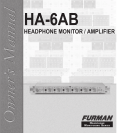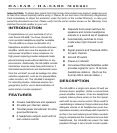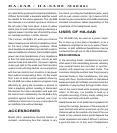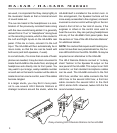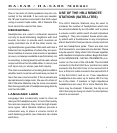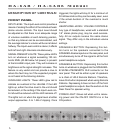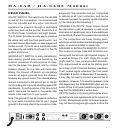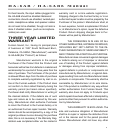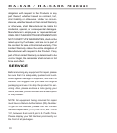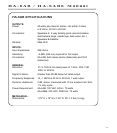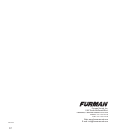
3
H A - 6 A B / H A - 6 A B E M a n u a l
ers, selected by pressing front panel pushbuttons.
Without the HA-6AB, a separate amplifi er would
be needed for the studio speakers. The HA-6AB
also features a convenient input level control on
the left side of the front panel. A pair of yellow
LED’s (one for each channel) light up whenever a
signal is present. Another pair of red LED’s shows
an overload condition in either channel.
The Furman HA-6AB’s 20 watts-per-channel
make it ideal as a low distortion headphone driver
for the most critical listening situations. While
most headphone amplifi ers provide half a watt or
less per headphone channel, the HA-6AB’s higher
power can drive headphones of any impedance
to their full rated listening level, and do so with
minimal noise and distortion. Its power capacity
is also just right for the small near fi eld monitors
used in most recording studios; as a comparison
with the main control room monitors, it can power
them without overpowering them. On the studio
fl oor, a set of small monitor speakers driven by
the HA-6AB can make a session progress more
effi ciently by giving the musicians a chance to
hear a playback without needing to disconnect
themselves from their equipment and walk into
the control room. Additionally, the HA-6AB is fully
protected against thermal overload, and it can
withstand a short circuit on any or all outputs for
an indefi nite time without damage.
ACCESSORIES
Model HR-2 Headphone Remote Station: A
compact, unobtrusive box that clamps to any
mic stand, providing two headphone jacks, each
with its own volume control. Up to twelve HR-2
boxes may be connected to a HA-6AB, employing
standard microphone cables (depending on the
impedance of the headphones used).
USES OF HA-6AB
The HA-6AB may be used as a power ampli-
fi er to drive up to two pairs of speakers, or as a
headphone amplifi er for one to six pairs of head-
phones, or both. Additional headphones may be
connected through use of HR-2 Remote Boxes.
RECORDING
In the recording studio, headphones are most
often used in the overdubbing process, whereby
new musical tracks are recorded in synchro-
nization with previously recorded tracks. The
musicians doing the overdub hear the previously
recorded tracks in their headphones, and play
along with them. Synchronization is maintained
because almost all multitrack recorders have the
capability of playing back through certain chan-
nels of the record head while recording through
others. In this way, it is possible to build up a
complete recording of many tracks, adding one
or more new tracks with each overdub.
Headphones are much preferred to speakers for
cueing the overdub, because of the presence of
open microphones which would pick up the cue
tracks as well as the overdub. Any trace of the cue
tracks in the overdub tracks would degrade the
tracks’ separation and make it diffi cult to achieve
a good mix later on. In fact, even if headphones



